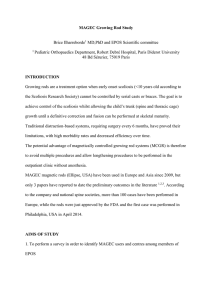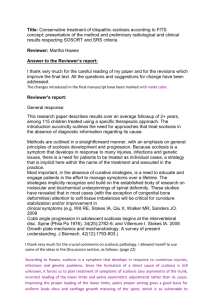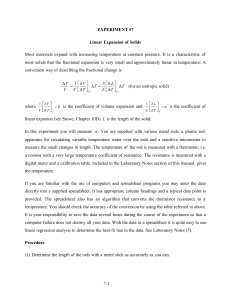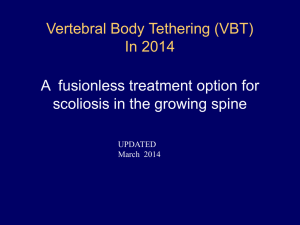Fusionless Correction fro Early Onset Scoliosis (EOS)
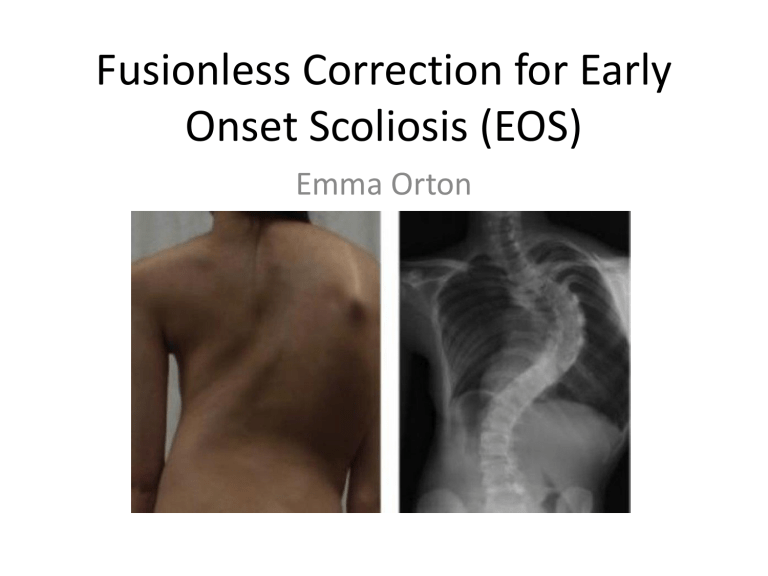
Fusionless Correction for Early
Onset Scoliosis (EOS)
Emma Orton
BME 281
What is EOS?
• Diagnosed before the skeletal age of 10
• There is a lateral curve of the spine
• Causes pulmonary problems later in life
• There are three different types
– Infantile Idiopathic- diagnosed between 0 and 3 years old and the patient is otherwise healthy
– Juvenile Idiopathic-diagnosed between 4 and 10 years old
– Congenital-is developed within the first 6 weeks of embryonic formation and is when vertebrae are not formed correctly
[1]
Cobb Angle
[2]
[3]
Possible Treatments
• Braces
• For older patients with a less severe curve
• will not be helpful for patients aged 2-7 years with curves of 50 to 60 degrees
• VECTR
• Vertical prosthetic titanium prosthetic rib
• Pushes ribs apart widening the thorax and straightening the spine
• Dual Growing Rods
• Growing Rods with Magnetic Expansion Control
• Spinal Fusion
• Many other surgical treatments
Why are Fusionless Treatments Better?
• When fusion is used the curve of the spine is improved but growth stops
• Fusionless treatments are important for children especially those under 10
• Children under 5 still have up to 12.5 cm of vertical growth
• Lungs do not fully develop till about 8 years old
• Fusion does work for patients who are fully grown
[4]
Criteria for Dual Growing Rods
The general criteria is:
• Significant potential axial growth remaining
• A deformity that is continuing to progress
• A deformity that is flexible or can be made flexible
Dual Growing Rods: Experiment 1
• 38 patients
• Followed for anywhere between 2 and 7 years
(on average 3.3 years)
• Patients received lengthenings on average every 6.8 months
• The cobb angle decreased from 74 degrees to
38 degrees on average
• There was axial growth (T1-S1)
[5]
Dual Growing Rod: Experiment 2
• 23 patients
• Cobb angle corrected from 82 degrees to 38 degrees on average
• On average 1.24cm per year of axial spinal growth
• Improvement of space in the thorax
• 13 complications with 11 patients
Dual Growing Rod: Experiment 3
• Group 1 had a single rod with a short apical fusion
• Group 2 had only a single rod
• Group 3 had dual rod implantation
• Group 1 had the worst results with 23% correction (6.4cm of axial growth) while group three had the best with 71% correction (12.1 cm of axial growth)
Pros and Con of Dual Growing Rod
Pros
• One of the most efficient ways of treating EOS
• Opens up the thorax preventing many future pulmonary issues
• Continues to allow for growth
Cons
• Each patient must receive an invasive surgery every six months for a span of a few years (usually till age
10 for girls and age 13 for boys)
• This leads to more opportunities to contract some kind of infection
• Very physically and psychologically grueling
Magnetically Controlled Growing Rods
(MCRG)
• Attached in basically the same way as the dual growing rods
• Lengthened during quick follow-ups in the office without any invasive surgery every 3-4 months
• This allows for the curve to be managed until their skeletal structure has matured enough for spinal fusion
• The EOS is then tracked using radiographs
[6]
[7]
MCGR
• This technique is very new in the United
States so not many hospitals are doing it
• The first one was completed in Washington DC on a ten year old boy
• The requirements are a skeletal age of 10 years old or younger and a Cobb angle of 50 degrees or greater
• Approved by the FDA in February of 2014
[8]
MCGR Experiment
Criteria
• Younger than 11 years old
• Major curve of at least 30 degrees
• Radiographic thoracic height (T1-T12) less then 22cm
• No previous spine surgery
• 2 year follow-up
The Experiment
• 12 MCGR patients
• 12 TGR patients
• All paired by gender number of rods, age, curve and type of EOS
[6]
Results
Major Curve Correction
• Very similar with MCGR and TRG patients
• Overall it was 32% and 33%
Spinal Height(T1-S1)
• MCGR- 8.1mm/year
• TGR- 9.7mm/year
• This is not considered significantly different
Throacic Height(T1-T12)
Height before surgery
MCGR
158mm
Height immediately following surgery 186mm
Growth per year
TRG
166mm
189mm
1.5mm/yr 2.3mm/yr
Results
MCRG
• 16 surgeries
• 137 noninvasive lengthenings
• 8 implant related complications
TRG
• 73 surgeries
• 12 for initial implant
• 56 for lengthening
• 11/12 had complications
• 4 surgical site infection and 13 implant related
NOTE: All of these patient were from different facilities so there could be some variations in results
[6]
Discussion of Results
• MCGR-does not allow for the sagittal plane to contour ideally because of where the actuator has to be located
• TRG-May produce better results when solely looking at numbers but when the surgeries and many complications are added in it is not ideal
• It is possible that the MCRG would have had results even more similar or better than the TRG results had there been a longer follow up
(average follow up for TR patients was 1.6 years longer)
References
[1] "Congenital Scoliosis." - Scoliosis Research Society (SRS). N.p., n.d. Web. 22 Sept. 2015. types of scoliosis
[2] "Anatomy of the Spine." Spine Anatomy : Southern Oregon Neurosurgical & Spine Associates,
PC. N.p., n.d. Web. 26 Sept. 2015.
[3] "MD Lingo." MD Lingo. N.p., n.d. Web. 26 Sept. 2015.
[4] Hershman, Staurt H., Justin J. Park, and Baron S. Lonner. "Fusionless Surgery for Scoliosis."
Fusionless Surgery for Scoliosis (2013): n. pag. Web. 22 Sept. 2015.
[5] "Frequently Asked Questions." Growing Spine
Foundation. N.p., n.d. Web. 22 Sept. 2015.
[6] Pawlek, Jeff B., and Growing Spine Study Group. "Traditional Growing Rods Versus
Magnetically Controlled Growing Rods for the Surgical Treatment of Early-Onset Scoliosis: A Case-
Matched 2-Year Study." 2.6 (2014): 493-97. Web.
[7] Controlled Growing Rods Treat Scoliosis in Children." MedGadget. N.p., n.d. Web. 22 Sept.
2015.
[8] Chueng, and Samartzis. "Management of EOS." N.p., n.d. Web.
